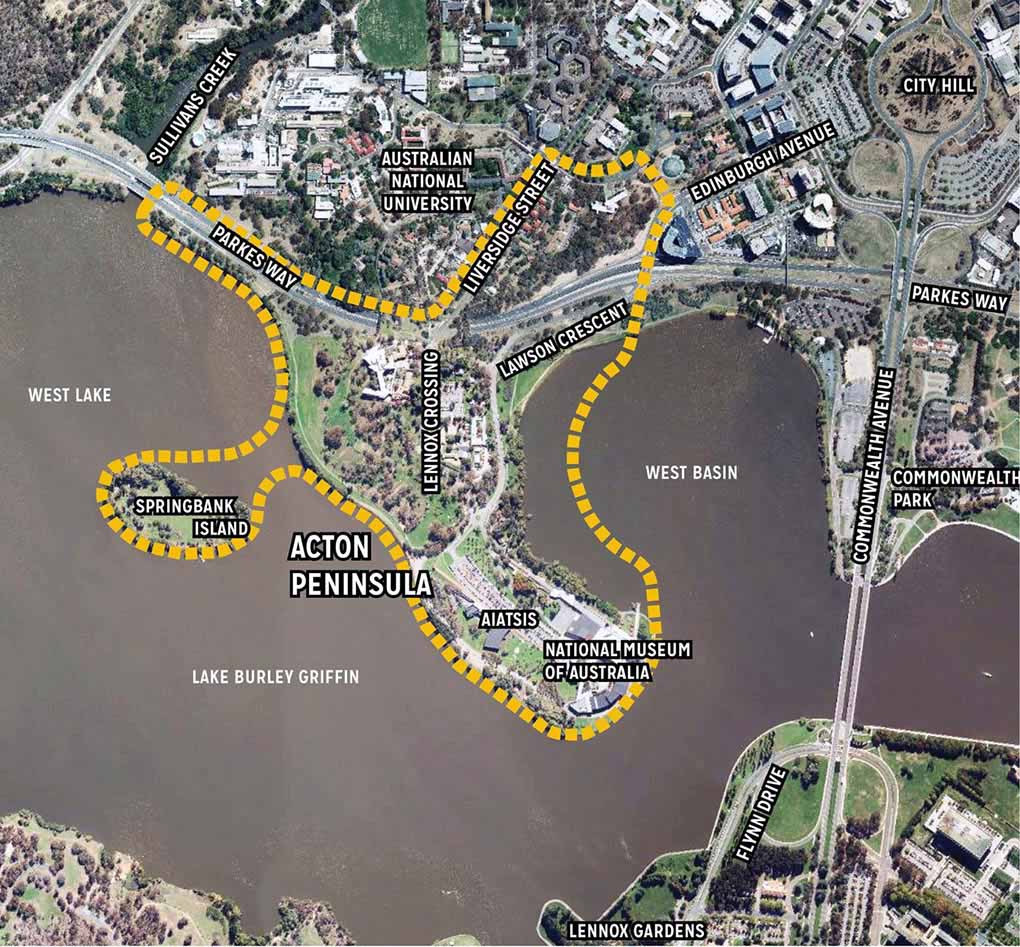2 May 2017
Collaboration to revitalise Acton Peninsula for the future
Today the National Capital Authority released the Acton Peninsula Precinct Draft Structure Plan for community consultation. The draft plan sets out the long-term planning policies to guide the future development of this prominent location into an internationally recognised precinct of culture, education and recreation.
The draft plan has been developed in close collaboration between the NCA and the cultural and educational institutions on and around Acton Peninsula including The Australian National University (ANU), the Australian Institute of Aboriginal and Torres Strait Islander Studies (AIATSIS), the National Museum of Australia (NMA), and the ACT Government.
NCA Chief Executive Malcolm Snow said that all the institutions had an exciting long-term vision for the peninsula which to be realised, needed a supporting urban design framework to ensure the proper development and management of the area.
‘The outcome of this collaboration is an ambitious shared aspiration to create an internationally recognised precinct that showcases Australia’s national identity and innovation capacity. This draft plan is the first step in starting a meaningful conversation with the community to seek their views on ideas to improve the quality of the public spaces on and around the peninsula and boost its potential as a place that supports exchange in all its forms. Globally, cities seeking to boost their competitiveness are recognising the economic and social value of harnessing the potential of their institutional assets,’ Mr Snow said.
Acton Peninsula is an outstanding natural feature in the Central National Area and is the setting for some of Australia’s most important cultural and educational institutions.
‘These institutions and the diverse activities they support are significant both at a local and national level. However, the existing connections and interactions between them are currently weak. The draft plan seeks to address this by resolving a range of physical constraints and proposing new opportunities to co-ordinate the long-term development of the precinct,’ Mr Snow said.
NMA Director Dr Mathew Trinca said that the popular site, which attracts thousands of visitors and tourists, would benefit from improved place-making opportunities.
‘The integration of built form and landscape to improve the public realm will strengthen the visitor’s experience and enable the peninsula to be transformed into a destination. The proposal speaks to the setting of the site and enhances its landscape quality,’ Dr Trinca said.
AIATSIS acting Chief Executive Officer Craig Ritchie reaffirmed the desire for the Peninsula to develop as one of Canberra’s premier gathering places.
‘Rich in culture and history, the way we share and tell our first peoples’ stories on the Peninsula has the potential to be enhanced through more imaginative and innovative uses of the space. We have the opportunity to create a connected and vibrant precinct that focuses visitors, educators and researchers on Australia’s unique culture,’ Mr Ritchie said.
ANU Executive Director of Administration and Planning Chris Grange is confident the draft plan will help inform each institution’s individual masterplans.
‘Through this collective vision, the Peninsula Partners will have an overarching framework to guide future planning initiatives and allow us to explore these possibilities with the community. The transformation of the site is a long-term vision, to be realised in decades to come,’ Mr Grange said.
City to the Lake Director with the ACT Government Nicholas Holt, said that the draft Structure Plan is designed to promote connectivity and blend the uses of the Peninsula to improve the public realm.
‘This is an opportunity to activate the Peninsula and to deliver seamless linkages to each of the surrounding precincts including the adjacent West Basin waterfront. An improved network of public open space will connect each area to produce an inviting, modern and active site,’ Mr Holt said.
The draft plan will inform the Acton Peninsula Precinct Code in the National Capital Plan.
‘The community can be assured that they will have a further opportunity to comment after this initial round of consultation, when we propose an amendment to the Plan,’ Mr Snow said.
Community consultation will be open for six weeks and ends at midnight on Tuesday 13 June 2017. Public information drop-in sessions with NCA planning staff will be held from 11am to 2pm on Thursday 18 May, Saturday 20 May and Tuesday 23 May at the National Museum of Australia. The draft plan and information about how to provide feedback is available on the NCA’s website at www.nationalcapital.gov.au.
Rich media
The following rich media is available:
in this Dropbox folder https://www.dropbox.com/l/scl/AADQ3sbsPtWLt9zVNFau2daVDi-epaUqmf8.
Background
Situated south-west of Canberra City, Acton Peninsula is a physically and visually prominent location for some of the most important cultural institutions in Canberra. The Australian National University, the National Museum of Australia and the Australian Institute of Aboriginal and Torres Strait Islander Studies are located here. The area covered by Acton Peninsula Precinct Draft Structure Plan:

